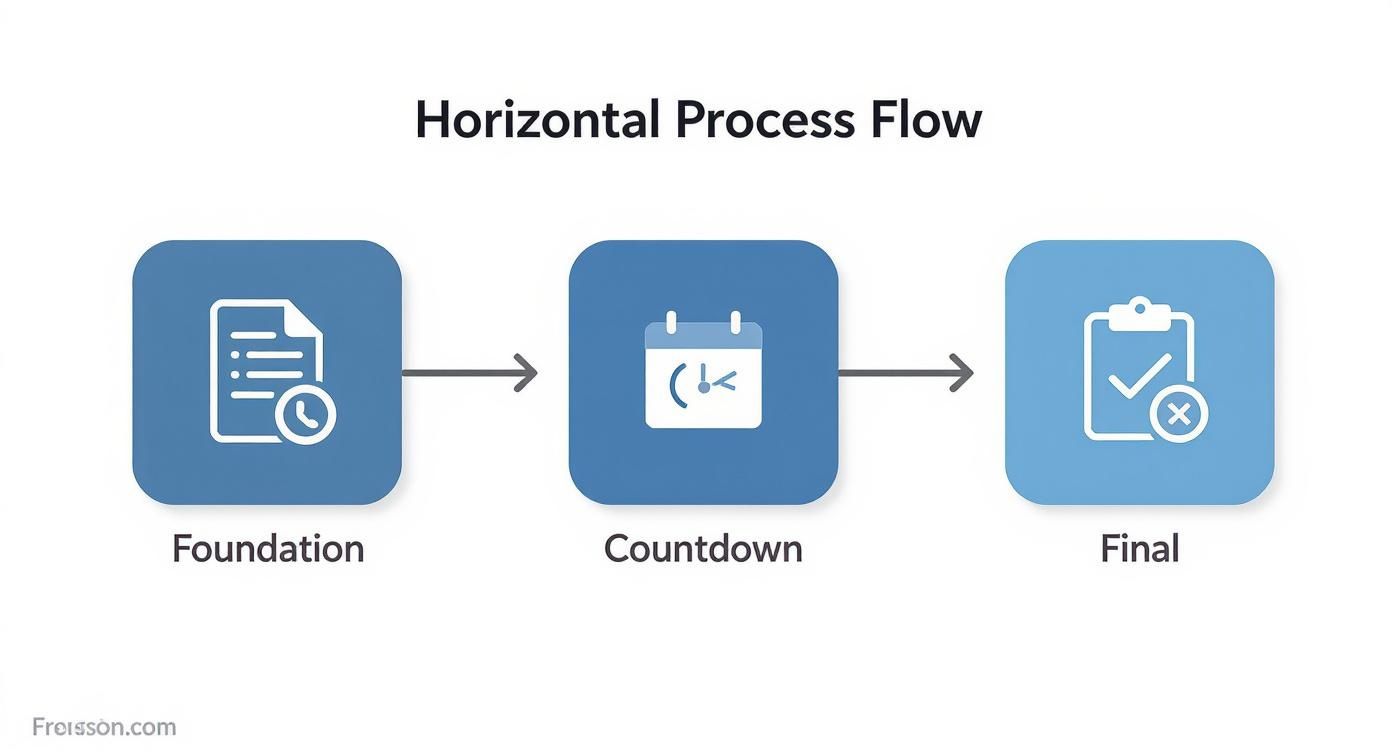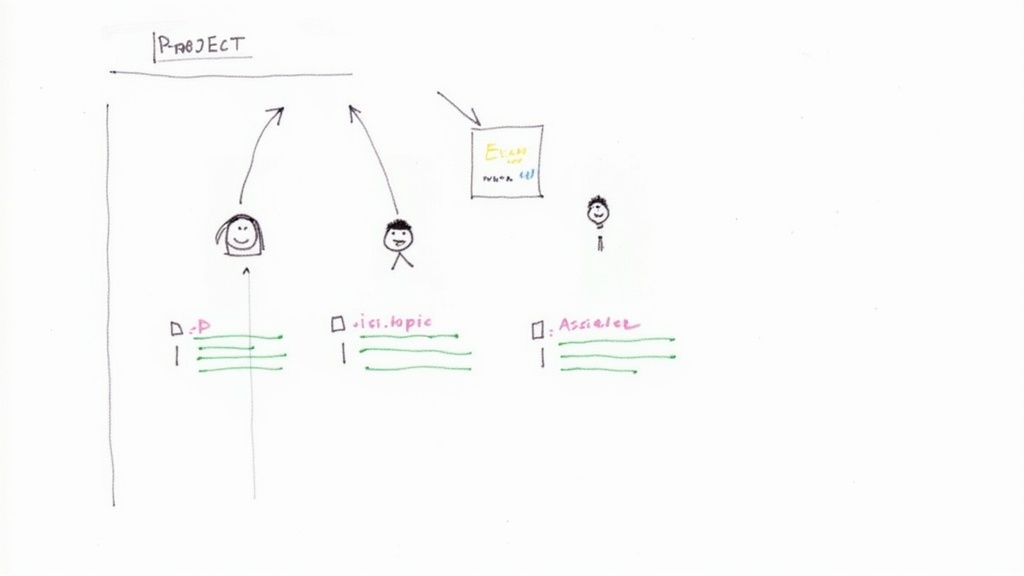November 15, 2025

A good event coordinator checklist template is so much more than a to-do list. Think of it as your command center, the strategic brain behind the entire operation. It's the tool that helps you manage risks, wrangle a million moving parts, and pull off a flawless event, whether you're planning a massive corporate summit, a virtual conference, or a hybrid trade show.
Let's be honest: in today's event world, a one-size-fits-all checklist is a recipe for disaster. I've seen it happen. Generic templates almost guarantee that critical details will be missed, leading to that last-minute scramble we all dread. They just don't account for the unique pressures and complexities we face as modern coordinators.
The industry is booming, and that's both exciting and challenging. The global events market is sitting at around $1,227.3 billion in 2024 and is expected to jump another 9.7% next year. This growth means more complexity. Events are no longer just one thing—we're juggling 60% in-person, 35% virtual, and 5% hybrid formats. A standard checklist just can't keep up with the wildly different tech and logistical needs of each. You can discover more insights about these event industry statistics and see for yourself how the landscape has changed.
A truly useful event coordinator checklist is built around the fundamental phases of event management. It guides your thinking from the first spark of an idea all the way through post-event analysis. This structure forces you to be proactive, to anticipate problems before they become full-blown crises. It's less about ticking boxes and more about building a solid, resilient plan. To really get this right, you first have to understand the core phases of event management.
A great checklist isn't just a list of tasks to complete. It's a communication tool, a risk mitigation plan, and a single source of truth that keeps your entire team, from vendors to stakeholders, perfectly aligned.
Trusting a generic checklist can have very real, very painful consequences. For example, a basic list might just say, "Book AV." A strategic checklist prompts you to ask the right questions: What's the venue's bandwidth for our livestream? Do they have backup generators? Forgetting to ask can lead to a complete technical meltdown on event day.
This is where a customized template really shines:
A well-designed checklist is structured around the natural lifecycle of an event. Each phase has its own focus and set of critical tasks that build on the last.
Here’s a quick look at how these phases break down in a comprehensive checklist, showing how each stage contributes to the final outcome.
Ultimately, organizing your checklist this way transforms it from a simple task list into a strategic roadmap, ensuring every detail is considered at the right time.
A truly powerful event coordinator checklist template isn’t something you download and use as-is; it’s a living document forged from experience. Think of it as your strategic blueprint, one that evolves and gets smarter with every event you pull off. We're going to build this master tool from the ground up, focusing on the core phases that turn a client's vision into a flawlessly executed reality.
Forget generic lists. What we're creating is a dynamic framework that serves as your starting point for any project, whether it’s a massive corporate conference, an intimate nonprofit gala, or a high-stakes product launch. A well-built template is everything. It’s like a restaurant launch checklist for a new eatery—a guide that ensures no detail, from the menu tasting to the final health inspection, gets missed.
This infographic breaks down the core phases of a strategic event checklist, showing how each stage builds on the last to create a successful outcome.

As you can see, it’s a clear progression. You start with the high-level strategy, move into the nitty-gritty logistics, and finish with on-the-ground execution.
This first phase is all about the "why" and the "how." It's where you sit down with your client, define what success actually looks like, and hammer out the budget. I’ve seen planners try to skip these foundational steps, and it’s like building a house without a blueprint—it’s destined to crumble under the first sign of pressure.
The goal here is to get everything on paper before a single dollar is spent or a vendor is called. Gaining that clarity upfront prevents costly scope creep later and ensures every decision you make serves the event's core purpose. For a deeper dive, check out our complete guide to strategic event management planning.
Your template for this phase should include checkpoints like:
With the strategy locked in, you dive headfirst into logistics. This phase covers the bulk of your planning activities, from securing vendors and signing contracts to launching your marketing campaigns. It’s easily the longest and most detailed part of any event timeline.
This is where you'll spend most of your time, turning those abstract ideas into concrete arrangements. Every task has a domino effect, so organization is key. A great template will break this massive phase into smaller, more manageable sub-categories.
The Pre-Event Countdown is where your organizational skills truly shine. It's about securing the best partners, negotiating contracts that protect your client, and building the operational backbone of your event.
Here are the critical sub-categories to build into your master checklist:
Venue & Logistics
Vendor Management
Marketing & Registration
By structuring your template around these distinct phases and detailed sub-categories, you’re creating a robust and adaptable tool. This isn’t about just reacting to tasks as they pop up; it’s about strategically navigating the entire event lifecycle. It's the framework that brings order to the beautiful chaos of event planning, freeing you up to focus on creating an unforgettable experience.
Let's be honest: the days right before an event and the weeks just after are where a great event coordinator truly shines. The big-picture plan is set, but these phases are all about relentless execution and smart analysis. This is where a dedicated event coordinator checklist template stops being a document and becomes your command center.
The final 48 hours before the doors open are an absolute whirlwind. You're juggling confirmations, running rehearsals, and stamping out last-minute fires. This is no time for high-level strategy; it's all about tactical precision. Your checklist here is your "Final Countdown" script, making sure every detail is triple-checked and every team member knows exactly what to do and when.

This isn't your master plan; it's a micro-checklist, your boots-on-the-ground playbook. It goes way beyond vague tasks like "confirm vendors." For example, instead of a simple "speaker arrival" checkbox, your list should prompt you to personally confirm their flight status and re-verify their ground transportation details.
Think through the "what-ifs." What happens when your keynote speaker's flight gets delayed? A good checklist will have an item for creating and distributing an emergency contact sheet with every key player's cell number—from the AV lead to the venue manager—so you can communicate schedule changes instantly.
Here are a few must-haves for your final 48-hour list:
The pre-show phase is less about planning and more about proactive problem-solving. Your checklist should anticipate potential points of failure and have a solution ready before anyone else even knows there's an issue.
Once the last guest is out the door, the work of proving your success begins. It’s tempting to just collapse from exhaustion, but this is where you gather the gold that makes your next event even better. This is also how you prove your value to your clients or stakeholders.
A detailed post-event checklist ensures nothing slips through the cracks, from closing out the books to digging into performance data. This is so important for showing a return on investment—a huge challenge for many in the industry. With rising costs, like unexpected food and beverage expenses (cited by 61% of respondents), a meticulous financial wrap-up is non-negotiable. And considering 95% of professionals are focused on improving ROI measurement, a systematic post-show process is essential.
Your post-show template should walk you through these key actions:
Your master event coordinator checklist template is an incredible starting point, but its real magic comes from its adaptability. A template should never be a rigid set of rules. Think of it as a flexible framework you can shape to meet the specific needs of any event you’re tackling.
The idea is to take that solid, all-purpose foundation and turn it into a specialized action plan. It's like an architect's work: the core principles of design apply to both a skyscraper and a small home, but the final blueprints are completely different. Your master checklist holds the principles; now you need to draw the unique blueprints for each event.
When you're planning a virtual summit, your entire focus shifts from physical logistics to the digital experience. Your checklist has to make that same pivot. Vague tasks like "confirm venue" are out, replaced by critical tech and engagement-focused to-dos.
You'll want to add entire sections dedicated to the online environment:
A product launch is pure performance. It’s all about creating media buzz and driving those crucial first sales. Your checklist needs to be laser-focused on PR, media coordination, and building an unforgettable brand experience. General attendee comfort takes a backseat to crafting the perfect story for the press and your top influencers.
Your product launch checklist should have dedicated sections for:
An effective event coordinator checklist template isn't a static document. It's a dynamic tool that anticipates the specific pressures and priorities of the event you're actually planning.
Corporate events and nonprofit fundraisers are two more classic examples where specialization is everything. For a corporate conference, the priorities are professional development, networking, and flawless execution that makes the company shine. For a much deeper dive, our article on how to plan corporate events has you covered.
Here’s a great example of how you can organize a checklist inside a project management tool like Asana.
This kind of visual layout is incredibly helpful. You can see every task organized by phase, with clear deadlines and owners, which simplifies managing even the most complex projects.
For a nonprofit fundraiser, on the other hand, the checklist needs to revolve around the donor experience and maximizing contributions. You'll be adding tasks for tracking sponsorship deliverables, planning a silent auction from procurement to checkout, and designing a smooth, simple donation process for the event itself.
By creating these kinds of "plug-and-play" modules for different event types, your master template becomes a powerful, endlessly versatile tool, ready for whatever challenge comes next.
A static spreadsheet is a decent starting point, but let's be honest—it’s not enough for a real-world event. To truly run the show, you need to transform that personal event coordinator checklist template into a dynamic, shared command center for your entire team. This creates a single source of truth, killing confusion before it even starts and keeping everyone perfectly in sync.
When you move your checklist into a collaborative platform like Asana, Trello, or Monday.com, the benefits hit you immediately. You can instantly assign tasks to specific people, set up automated reminders so you don't have to chase anyone down, and attach crucial documents—like vendor contracts or floor plans—directly to the relevant tasks.

This isn’t just about convenience; it’s a smart career move. The demand for skilled event planners is on the rise, with a projected 5% employment growth expected by 2034. As the industry gets more competitive, your efficiency is your edge. It's no wonder that 67.4% of planners are already swapping out their old software for better collaborative tools. You can dig deeper into the numbers by exploring the full report on event planner employment growth.
Making this switch is surprisingly easy. Most of these platforms let you import tasks straight from a spreadsheet, or you can often just copy and paste your list.
The goal is to build an interactive project board. I’m a big fan of the Kanban-style layout, with columns like "To Do," "In Progress," and "Done." This gives your whole team a quick, visual snapshot of where every single task stands without them having to ask you.
A collaborative checklist isn't just for tracking what's done. It's about creating total transparency. When your team sees the full picture, they start to anticipate needs and solve problems on their own, which means fewer "quick question" interruptions for you.
This is where you really start to feel the muscle of modern event management software. You’re no longer just ticking off boxes; you’re conducting an orchestra.
Once you're set up, start playing with some of the more powerful features:
Even with a rock-solid plan, questions always pop up when you're deep in the trenches of building and using an event coordinator checklist template. Getting those nagging questions answered is what turns a simple document into your most valuable planning asset. Let's tackle some of the most common ones I hear from fellow event pros.
Honestly, the "best" format really depends on the complexity of your event and how many people are on your team. You don't always need to bring in the big guns.
For smaller gigs you’re wrangling mostly by yourself, a well-organized Google Sheet or Excel file is a fantastic workhorse. They’re straightforward, everyone knows how to use them, and you can tweak them endlessly. But when you're coordinating a larger event with a full team, that's when you'll want to graduate to a project management tool. Something like Asana or Trello becomes essential for assigning tasks, setting deadlines, and seeing who's doing what in real-time. That kind of visibility is a lifesaver when you've got multiple moving parts.
My best advice? Make it a habit to refine your master template after every single event. Seriously. Don't just archive the project and move on.
During your post-event wrap-up meeting, make it a point to ask your team, "What did we forget to put on the checklist?" or "Which task was confusing or could have used more detail?" This is how your template gets smarter. Each event gives you new lessons, and baking those lessons right back into your master checklist ensures you don't make the same mistake twice.
The most effective event checklists are living documents. They evolve with your experience, capturing lessons learned from both your biggest successes and your most challenging moments, making each future event run smoother than the last.
This is the million-dollar question, isn't it? You can't just drop a new tool on your team and expect them to adopt it. Getting buy-in is everything.
First off, bring them into the process. When you're creating or updating the template, ask for their input. When people have a hand in building the tool, they feel a sense of ownership and are way more likely to use it.
Second, you have to make the checklist the single source of truth for the entire event. Run your weekly planning meetings directly from the project board in Asana or Trello. When all updates, questions, and progress reports live inside the checklist, it stops feeling like an extra administrative chore and becomes the central hub for your entire operation. Consistent use will just happen naturally from there.
Ready to stop juggling spreadsheets and start building seamless event experiences? GroupOS is the all-in-one platform designed to manage everything from registration and ticketing to team collaboration and post-event analytics. See how our tools can elevate your next event by learning more about GroupOS.


